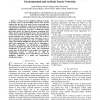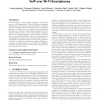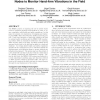MOBISYS
2007
ACM
14 years 5 months ago
2007
ACM
— Perhaps the most significant challenge in design of on-body sensors is the wearability concern. This concern requires that the size of the nodes (sensors, processing units and ...
MOBISYS
2007
ACM
14 years 5 months ago
2007
ACM
In-home monitoring using sensors has the potential to improve the life of elderly and chronically ill persons, assist their family and friends in supervising their status, and pro...
MOBISYS
2007
ACM
15 years 3 months ago
2007
ACM
IP based telephony is rapidly gaining acceptance over traditional means of voice communication. Wireless LANs are also becoming ubiquitous due to their inherent ease of deployment...
MOBISYS
2007
ACM
15 years 3 months ago
2007
ACM
We report on the design, implementation, and evaluation of a system called Cedar that enables mobile database access with good performance over low-bandwidth networks. This is acc...
MOBISYS
2007
ACM
15 years 3 months ago
2007
ACM
In this work, we investigate the use of directional antennas and beam steering techniques to improve performance of 802.11 links in the context of communication between a moving v...
MOBISYS
2007
ACM
15 years 3 months ago
2007
ACM
Software failures in wireless sensor systems are notoriously difficult to debug. Resource constraints in wireless deployments substantially restrict visibility into the root cause...
MOBISYS
2007
ACM
15 years 3 months ago
2007
ACM
In this paper, we propose a simple yet effective method of identifying traffic conditions on surface streets given location traces collected from on-road vehicles--this requires o...
MOBISYS
2007
ACM
15 years 3 months ago
2007
ACM
Except for a handful of "mobile" Web sites, the Web is designed for browsing with personal computers with large screens capable of fitting the content of most Web pages....
MOBISYS
2007
ACM
15 years 3 months ago
2007
ACM
We consider the problem of providing vehicular Internet access using roadside 802.11 access points. We build on previous work in this area [18, 8, 5, 11] with an extensive experim...
MOBISYS
2007
ACM
15 years 3 months ago
2007
ACM
The NEMO project is exploring the use of mobile sensor nodes to augment physical work artefacts in order to ensure compliance with health and safety regulations. In this paper we ...



